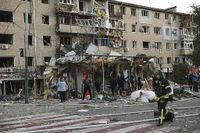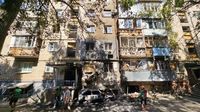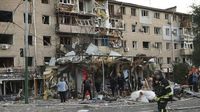In the dark hours between August 30 and 31, 2025, southern and central Ukraine once again became the epicenter of a devastating Russian aerial onslaught. According to Ukrainian officials and multiple international news outlets, Russia unleashed a barrage of 537 drones and decoys, alongside 45 missiles, targeting cities and frontline regions already battered by months of war. The Zaporizhzhia region, in particular, bore the brunt of the attack, with a five-story residential building struck—killing at least one woman and wounding 28 others, including children, as reported by regional governor Ivan Fedorov and corroborated by the Associated Press.
This latest escalation came just two days after a rare and deadly Russian airstrike on central Kyiv claimed 23 lives and damaged the offices of the European Union and the British Council. The Thursday attack on the Ukrainian capital was the deadliest of the summer, according to Getty Images and EPA/Shutterstock. Flowers now line the rubble where Ukrainian rescue teams worked for hours to pull survivors from the debris, a chilling reminder of the war’s human toll.
Ukraine’s air defenses, while formidable, were stretched to their limits. The Ukrainian Air Force reported shooting down or neutralizing 510 drones and decoys and 38 missiles during the overnight assault. Nevertheless, five missiles and 24 drones managed to evade interception, striking residential buildings and sparking massive fires, as detailed by Global Images Ukraine and Ukrainian military statements. Explosions were also reported in Kherson, Odesa, Dnipro, and beyond, affecting as many as fourteen regions, including Kharkiv and Donetsk, according to President Volodymyr Zelenskyy.
In Kherson, local media reported at least two fatalities and 14 injuries after drones struck nine houses, medical and educational facilities, an administrative building, a gas station, and several cars. Odesa suffered significant infrastructure damage, especially in the city of Chornomorsk, where at least one person was injured and over 29,000 residents were left without electricity. District Governor Oleg Kiper noted on Telegram, "Restoration work has already begun. Critical infrastructure is powered by generators." The city’s swift response, even amid chaos, has become emblematic of Ukraine’s resilience.
This was the third large-scale Russian attack on Ukraine in just one week. President Zelenskyy, in a series of statements on X (formerly Twitter) and to international media, warned, "There were two large-scale attacks by Russia this week—absolutely brazen actions, through which Russia is demonstrating that without pressure from the world, there will be no end to the war." He accused Vladimir Putin of "only duping leaders and drawing them into his camp" and staving off the threat of sanctions, emphasizing, "Nothing else interests him. It is important that together we press Russia into ending this war."
The intensity of Russian operations has not gone unnoticed by military analysts. General Valery Gerasimov, chief of Russia’s general staff, boasted that Moscow’s forces have captured more than 3,500 square kilometers of Ukrainian territory and 149 settlements since March 2025. Russian troops recently broke into the southeastern Dnipropetrovsk region, capturing seven settlements as of August 30, a move widely interpreted as an attempt to strengthen the Kremlin’s hand in any future negotiations.
Meanwhile, Ukrainian forces have not stood idle. The Ukrainian general staff reported successful strikes on Russian oil refineries in the Krasnodar and Samara regions overnight August 29-30. Russian authorities confirmed a fire at the Krasnodar refinery, which produces approximately 3 million tons of petroleum products annually. No casualties were reported, but the damage to energy infrastructure was significant. The ripple effects were immediate: gas stations in several Russian regions ran dry, leading to rationing and a government-imposed gasoline export ban until late October. The shortages have exposed a vulnerability in Russia’s homefront, with analysts predicting the crisis may ease only after the summer maintenance period concludes.
Ukraine’s President Zelenskyy has used these attacks to underscore the need for continued international support. "The only way to reopen a window of opportunity for diplomacy is through tough measures against all those bankrolling the Russian army and effective sanctions against Moscow itself—banking and energy sanctions," Zelenskyy wrote on X. He added pointedly, "This war won’t stop with political statements alone; real steps are needed. We expect action from the U.S., Europe and the entire world."
Hours after the deadly strike on Kyiv, the United States approved an $825 million arms sale to Ukraine, including 3,350 Extended Range Attack Munition (ERAM) missiles and 3,350 GPS units to bolster Ukraine’s defensive capabilities. This move was swiftly followed by renewed calls in the European Union to seize frozen Russian assets and transfer them to Ukraine. European Commission President Ursula von der Leyen declared, "It’s clear that the predator has to pay for what he did," referring to Putin. However, not all EU members are united on this approach. Belgian Foreign Minister Maxime Prévot warned that such measures "would trigger a system financial instability, and also erodes trusts in the euro," advocating instead for keeping the assets frozen until Russia pays reparations. These debates unfolded at a summit of EU foreign and defense ministers in Copenhagen, where officials also discussed ramping up defense supplies to Kyiv and Ukraine’s prospects for joining the 27-nation bloc.
On the battlefield, the cost to Russian forces has been staggering. President Zelenskyy reported that in just the first eight months of 2025, Russian troops suffered more than 290,000 soldiers killed or severely wounded. In the embattled Donetsk region, particularly near Pokrovsk, Zelenskyy claimed that Ukrainian units "continue to carry out their assigned tasks and methodically destroy the occupier." He emphasized that Moscow’s army was concentrating its greatest efforts there, but that Ukrainian resistance remained unbroken.
Peace negotiations, meanwhile, appear to be at a standstill. Despite the recent presidential summit in Alaska between Donald Trump and Vladimir Putin—which ended Putin’s diplomatic isolation in the West—there have been few tangible steps toward ending the conflict. Ukraine has accepted a U.S.-proposed ceasefire and a meeting between Putin and Zelenskyy, but Moscow has raised objections. Trump, in an interview with the Daily Caller, expressed waning confidence in his ability to arrange direct talks, stating, "We got along. You saw it, we’ve had a good relationship over the years, very good, actually. That’s why I really thought we would have this done. I would have loved to have had it done."
As the war grinds into its third year, both sides continue to suffer and inflict heavy losses. The latest attacks have left thousands of Ukrainians without homes, electricity, or peace of mind, while Russia faces new vulnerabilities and diplomatic challenges. In a chilling development, former Ukrainian parliament speaker and pro-Western politician Andriy Parubiy was shot dead in Lviv on August 30. President Zelenskyy condemned the "terrible murder" and promised a thorough investigation, adding yet another layer of tragedy to an already fraught landscape.
With negotiations deadlocked and violence escalating, Ukraine and its allies face a critical juncture. The world watches closely, hoping for decisive action that can finally bring an end to the suffering—before another night brings more devastation.



